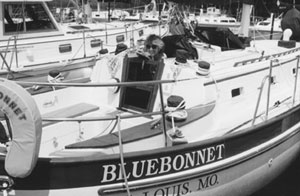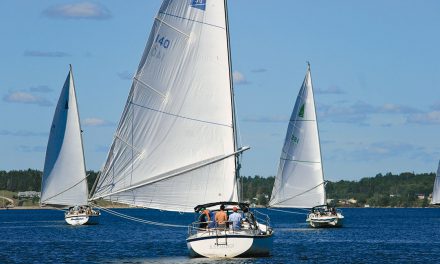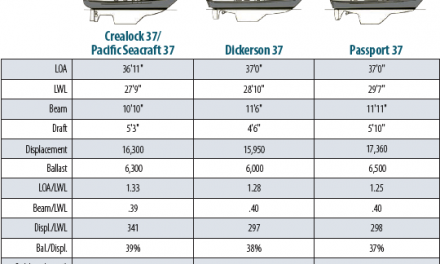
Jeanette Ralph enjoys her gorgeous “new” boat and the prospect of retiring in style
The Valiant 32 was designed by Bob Perry as a smaller version of the successful Valiant 40. In the 1970s, a 30- to 35-foot boat was considered the optimum-size boat for a cruising couple. In response to this demand, the Valiant 32 was produced. About 67 were built in the late 1970s and early ’80s. The boat is 32 feet on deck with a waterline length of 26 feet. The beam is 10 feet 5 inches, and displacement is 11,800 pounds. Ballast is 4,700 pounds, and the displacement-to-length ratio is 283. This translates into a boat that is moderate in displacement, yet extremely seaworthy. It has the traditional Valiant lines with the canoe stern and moderate flare at the bow. The underbody features a modified fin keel with external ballast and a skeg-hung rudder. The hull is laid up in solid laminate, and the deck and cabintop is balsa-cored.
The interior, as you come down the companionway steps, has a U-shaped galley to port with a forward-facing navigation station to starboard and a quarterberth aft. Forward of the galley and nav station, are opposing settees with a drop-leaf table around the keel-stepped mast. The port settee slides out to make a small double/twin bed. There is storage behind and under the settees. Farther forward, the head is to port with a large hanging locker to starboard. The door to the head swings aft and will latch to the hanging locker to give a privacy area for the V-berth. Our boat has an optional large hanging wet locker with a storage shelf aft, instead of the quarterberth. We don’t miss the quarterberth, and lee cloths on the starboard settee work very well for a sea berth. Others have commented that they ended up with their quarterberth being used as a storage area anyway.
The boat is powered by a 4-cylinder 25-hp, L-25 Westerbeke diesel. Ours has never given us any problems. Tankage is 48 gallons of fuel and 80 gallons of water. The engine burns a half gallon an hour at hull speed which translates into a cruising range under power of more than 500 miles.
Most Valiant 32s are cutter rigged, which breaks the sail area down into an easily managed sail plan. With the mast stepped aft for the inner forestay, the boat develops weather helm when winds exceed 15 knots, but with the first reef in the main, it balances nicely. The boat is a dry boat and sails best with the rubrail (about 10 inches below the caprail) out of the water. We have sailed in winds higher than 35 knots with two reefs in the main while remaining fairly comfortable and never feeling out of control. The standing rigging is very substantial for a 32-foot boat. The headstay, backstay, and uppers are 5/16-inch 1×19 and the lowers, inter-forestay, and intermediate backstays are 1/4-inch 1×19. A few late V-32s were sloop-rigged with the mast stepped farther forward. This was in part to reduce the weather helm and to cut production costs. We have installed a large “pelican hook” on our inner forestay. For local light-wind sailing, we tie the inner-forestay and staysail in its bag back by the mast and sail the big genoa as a sloop.
In overall appearance, the Valiant 32 is similar to the Pacific Seacraft Crealock 34. Both boats have canoe sterns, but the form varies. The Valiant’s stern is fuller and somewhat broader in the “hips,” while the Crealock’s stern is more pointed. While the Crealock 34 is two feet longer on deck, both boats have the same waterline length and beam. Displacement is similar. Interior layouts are practically identical.
Since Rich Worstell, the present owner of Valiant Yachts, moved production to Texas in the early 1980s, the Valiant 32 has not been in production.
Article taken from Good Old Boat magazine: Volume 2, Number 2, March/April 1999.





